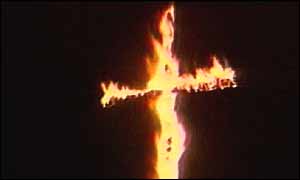 What can you say about the latest string of predawn church fires down in Alabama?
For starters, you can say that coverage of this story never really caught fire in the mainstream press and, if you dig down into the news stories, it is pretty easy to figure out why.
What can you say about the latest string of predawn church fires down in Alabama?
For starters, you can say that coverage of this story never really caught fire in the mainstream press and, if you dig down into the news stories, it is pretty easy to figure out why.
Reporter Rick Lyman of The New York Times' national desk has been on the scene, and here are two of the crucial sections of one of his recent stories. Let's start with the lead, which is precisely what you would expect in one of these stories:
The little rural churches of Alabama are like anchors for their small, often struggling towns, but nowhere more so than in this sparsely populated and predominantly black swath of the state's far western edge, home to four of the nine Baptist churches that arsonists have destroyed or damaged in Alabama during the last week.
"Church is where the people come together out here," said William L. Johnson, a Greene County commissioner. "We marry there and we worship there and we bury our families there. But they're more than that. During the week we don't see each other so much, but on Sunday we get together, and church is where we do it."
Investigators do believe that the people lighting the fires have been seeking out specific churches -- for some unknown reason. Why do they think that? Lyman notes that the arsonists have been driving past dozens of churches to find their targets.
It's easy to read between the lines of this trend, with our minds flashing back to familiar images in the racist past, including all of those flames in the mid-1990s when more than 50 small black churches burned throughout the Southeast. Yet, quite a ways down in the story, we find out:
Five churches within a 15-minute drive of one another in Bibb County, about a half-hour east of Tuscaloosa, were burned in the hours around dawn on Feb. 3. All were Baptist churches. Four had predominantly white congregations, and one was black. Then, four nights later, arsonists struck four churches in three western Alabama counties -- Greene, Sumter and Pickens -- about a half-hour to the west and southwest of Tuscaloosa. Again the targets were Baptist churches, though this time they all served poor, black congregations.
So what's the motive? Officials are suggesting that the arsonists may have been mere thrill-seekers. If so, why did they drive past other churches? Perhaps, notes Lyman, they were driven by "some deep-seated hatred of religion in general and Baptists in particular."
Now, a report by Jay Reeves of the Associated Press notes that authorities are hunting for a pair of young white men in an SUV that witnesses said was near several of the fires. A federal agent called them "bosom buddies" and suggested that they may have been injured in one of the fires.
And once again, we are left with this strange, unsettled conclusion:
Investigators have said they don't know a motive, but there is no racial pattern. Five of the churches had white congregations and five black. All were Baptist, the dominant faith in the region, and mostly in isolated country settings.
In other words, lacking the racial hook, this story is not a major, national story because the victims do not fit into an standard template for hate-crime coverage. I mean, might this actually be a case of anti-Baptist bigotry? Perhaps they drove past mainline churches to torch the Baptists? That doesn't sound like something a pair of Southern, thrill-seeking good ol' boys would do, does it? So what are we dealing with here? I hope that we find out.
UPDATE: The latest Times story has gone silent on issues of race and motive. But Alabama authorities have rolled out a massive hunt for the arsonists.
